Expressive Structure
Castle in the Sand
A subterranean museum with spectacular domelike galleries opens up to ocean views.
UCCA Dune Art Museum | Qinhuangdao, China | OPEN Architecture
By Aric Chen
Photography By Wu Qingshan
A passerby could easily miss the new UCCA Dune Art Museum, by Li Hu and Huang Wenjing of Beijing-based OPEN Architecture. Located on a strip of sand on the Bohai Sea—not far from Beidaihe, the summer retreat of China’s Communist Party leaders—the 10,000-square-foot museum lies mostly hidden, literally buried within one of the last remaining natural dune formations on the country’s northeast coast.
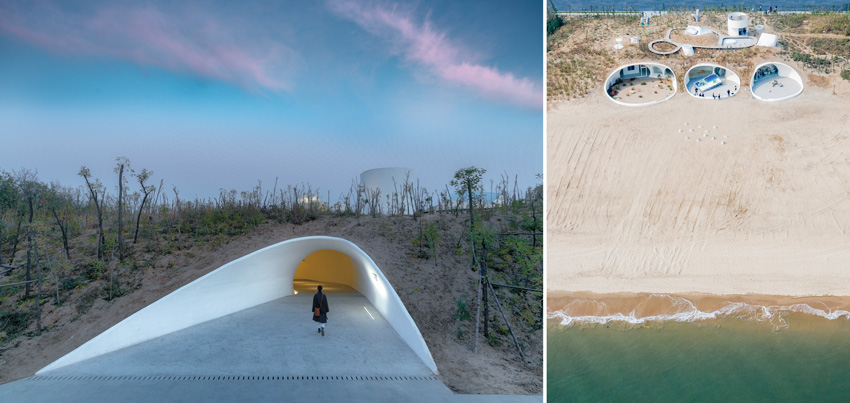
PHOTOGRAPHY: © NI NAN
BEACHFRONT PROPERTY
Visitors enter through a long tunnel (left). The museum’s outdoor terraces poke out from the sand and scrub (right).
From the outside, just a few tubular skylights, a small stair tower, and glimpses of the parabolic concrete shells tracing the museum’s outdoor terraces poke out from the sand and scrub. Inside, daylight filters generously into a warren of seven otherwise cavernous galleries, their domelike spaces warping and shape-shifting like a cluster of giant soap bubbles fossilized in concrete. “It connects to something ancient and timeless,” Li says of the project, whose three terraces open to expansive sea views. “We wanted to encourage people to think about their relationship with art, and with nature,” Huang adds.
While the museum opened in October as an outpost of the well-regarded Ullens Center for Contemporary Art in Beijing, its function wasn’t fully determined at first. Situated in a quiet corner of a sprawling, impeccably pruned enclave of luxury homes, shops, and resort hotels, OPEN’s project is one of several “follies”—including a widely publicized library and chapel by the Chinese studio Vector Architects—that were commissioned for the beachfront by Aranya, the property developer.
The original brief vaguely called for a space for art and dining. Midway, the art took over, prompting OPEN to convert a planned kitchen into the museum’s only somewhat rectangular gallery (a small café remains). However, changes in program were hardly the only cause for improvisation. The museum’s construction called for excavating the existing dune and erecting the museum’s structure before replacing the sand on top. (“We built into the dune in order to save it,” Li says of the formation, which would probably have been slated for demolition.) The entire building—including a dramatic, structural spiral stair leading up to the dune’s ridge—would be cast in concrete. But the question remained as to how.
Li and Huang took broad license in exploring possibilities. They considered specially fabricating steel ribs and trusses that could support concrete formwork. However, that proved to be too time-consuming and costly. They explored using CNC-milled foam, but the foam would be too fragile. Taking an experimental and conceptual leap, they even looked at erecting mounds of sand that could be sprayed in shotcrete and then hollowed out once the latter set—“sort of obvious, given the context,” Li says—or, even more radically, doing the same using blocks of ice. (“We first visited here in winter, and were struck by how the ocean was frozen,” Huang explains.)
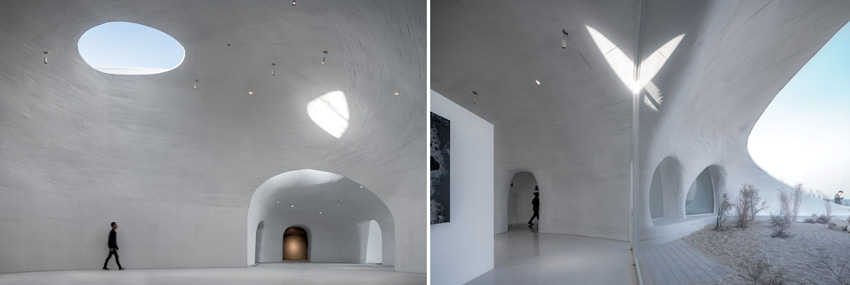
OTHERWORDLY
The subterranean galleries are filled with daylight, thanks to skylights and generous glazing.
In the end, the answer was indeed right in front of them, floating on the water. The surrounding area is known for its fishing boats. And with more advanced fabrication techniques being unfeasible, the architects turned to the local contractors, whose experience in boat construction meant they knew how to create complex curves in wood.
While the structure’s geometry was exactingly precise, its method of construction wasn’t. With a lattice of rebar in place, thus began an iterative design-build process that played out in real time as the contractors bent wood slats, planks, and boards into formwork, making on-the-spot adjustments along the way. There were digital models, of course, and lots of data, but also a 1:50 scale maquette for eyeballing. (A full-scale mock-up of one of the smaller galleries, which could be repurposed as a beachside changing room, was also erected.)
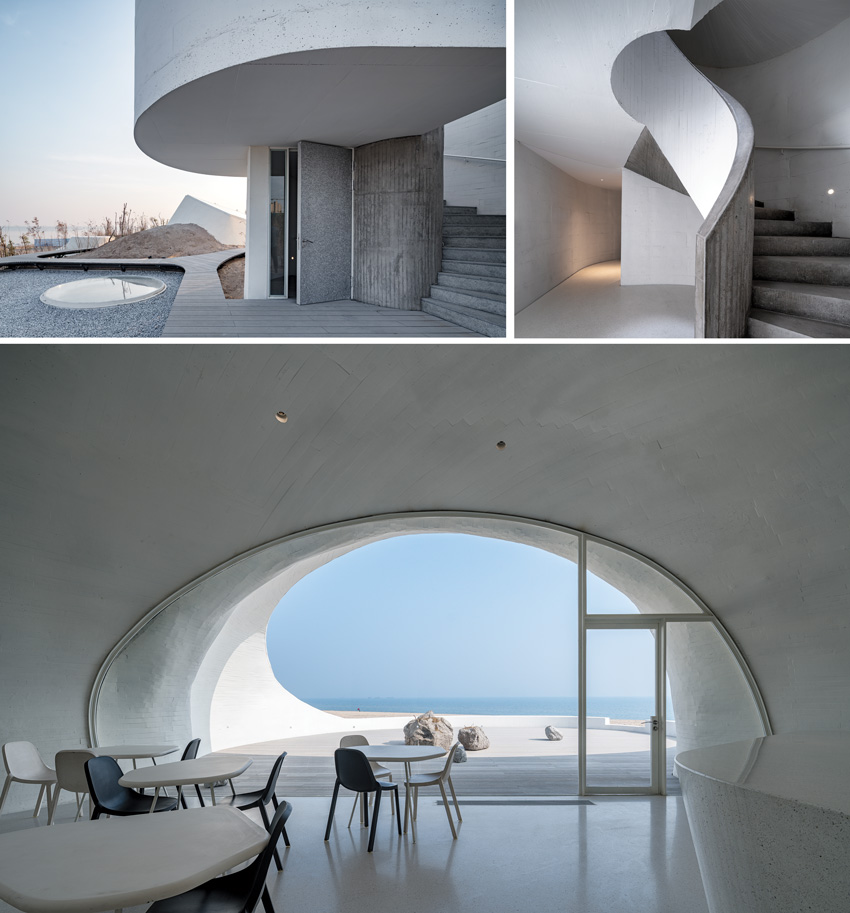
A muscular spiral stair (top, right) connects the rooftop (top, left) to the galleries and to a viewing platform up high. Like the galleries, the spare café is a domelike space whose concrete shell reveals the process of its making through its jumble of patterns and textures (bottom).
To further complicate matters, the concrete would need to be thicker at the base, while doorways and skylight apertures called for extra rebar reinforcement. On paper, 200-square-foot windows providing unobstructed views to the water could be easily mounted from the exterior. But, in reality, the building’s geometry got in the way, requiring workers to devise custom pulleys to install them from the inside. Throughout, details had to be continuously redrawn. And while the museum’s geothermal heating and cooling lay hidden beneath the floor, a grid of recessed spotlights were cast into the concrete above—and, as Li says, “you only get one chance at that.”
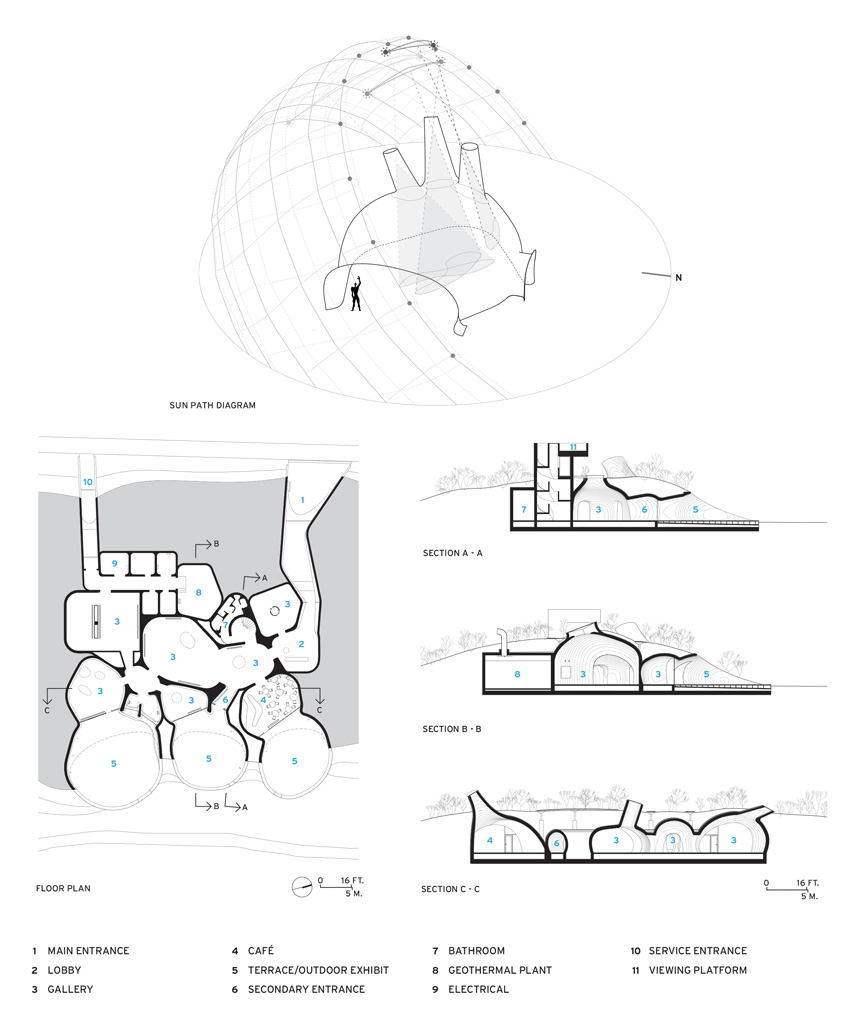
Most visibly, however, the formwork itself required a string of impromptu solutions, as different curves required different sizes of wood oriented in different directions—and, when all else failed, the workers cannily resorted to using sheet metal and even rubber tubing instead. Heightened by its contrast with the building’s polished white terrazzo floors, the resulting concrete shell almost viscerally reveals the process of its making through its jumble of patterns, textures, and even staple marks imprinted by the formwork.
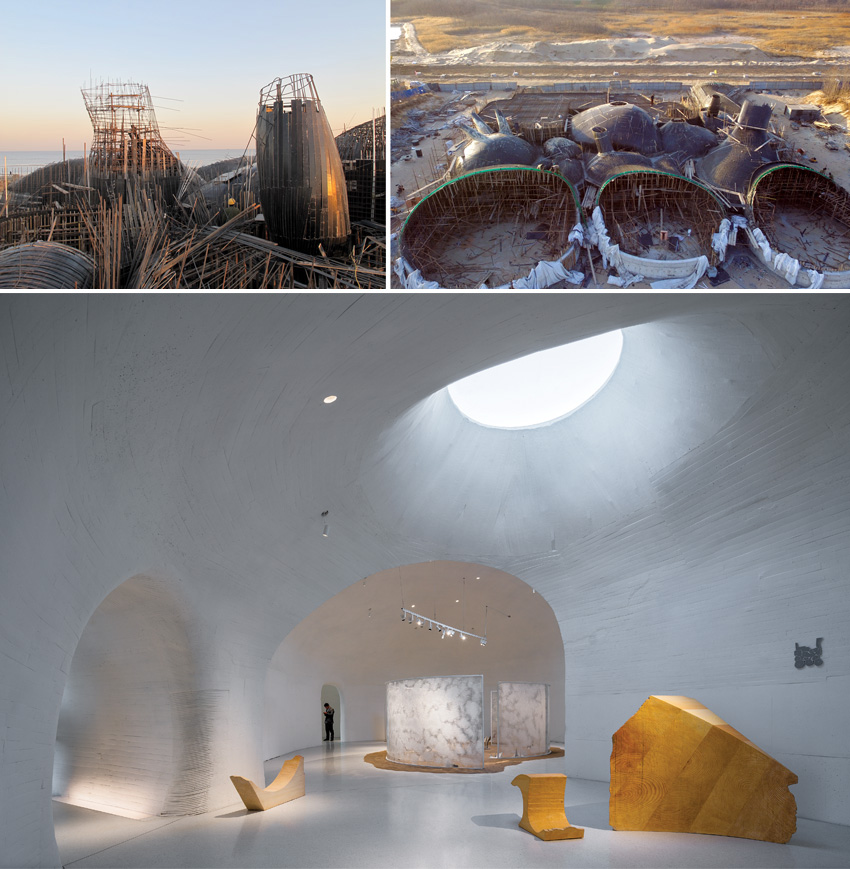
PHOTOGRAPHY: © COURTESY OPEN ARCHITECTURE
BY THE SEA
The architects turned to local shipbuilders for the formwork (top, left and right). The inaugural exhibition explores the shifting relationship between humans and nature in light of China’s last three decades of breakneck development (bottom)
From the start, Li and Huang had anticipated such flaws and planned to smooth them over with a layer of plaster. Then “we saw how beautiful the imperfections were and decided to keep them,” Huang says. And so the concrete was left exposed, adding to the sense, as Li puts it, that “the whole building is handcrafted.”

THE SHELTERING SKY
The terraces offer expansive ocean vistas after a visit to the galleries, and also double as outdoor exhibition areas.
In fact, the museum is one of a pair that OPEN has designed for the site; work is expected to begin next year on a “Sea Museum” that will be reached by a 500-foot-long causeway designed to disappear beneath the water at high tide. The Dune Museum, on the other hand, is not just embedded in the landscape. It also tracks the sky: two of its skylights orient to the sun at the summer and winter solstices, while others are designed to capture daylight or cast it on the walls.
When it came to the building’s construction, OPEN both drew from local know-how and embraced its limitations. The architects also skillfully worked with the terrain. When Li says that “we wanted to create a deep connection with the site,” he perhaps means it in more ways than one.
Aric Chen is an independent curator and writer based in Shanghai.
Credits
Architect: OPEN Architecture — Li Hu, Huang Wenjing, principals in charge; Zhou Tingting, Wang Mengmeng, Hu Boji, Fang Kuanyin, Joshua Parker, Lu Di, Lin Bihong, Ye Qing, Steven Shi, Jia Han, project team
Engineer: TCABR Technology (structural, mechanical, curtain wall)
Consultant: X Studio of the School of Architecture at Tsinghua University (lighting)
Client: Aranya
Size: 10,000 square feet
Cost: withheld
Completion Date: October 2018
Sources
Controls: Lutron
Hardware: Dorma
Chairs: Emeco
Sunshades: Silent Gliss International
Outdoor Decking: Woodn








